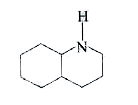Passage-4
An organic compound 'A' has molecular formula C9H13NO and it can be resolved into enantiomers. A does not decolourise bromine water solution. A on refluxing with dilute H2SO4 yields another resolvable compound B (C9H14O3) which gives effervescence with NaHCO3. B on treatment with NaBH4 yields C(C9H16O3) on heating with concentrated H2SO4 yields ester D(C9H14O2).
Compound A on reduction with LiAIH4, followed by treatment of H2SO4 yields following compound :

Due to reduction of optically pure' B' two isomeric product 'C' form. Isomeric product 'C' are :
Enantiomers
Diastereomers
Position isomers
Functional isomers
The correct Answer is:B
Similar Questions
An organic compound A has molecular formula C10H17Br and it is non-resolvable. A does not decolourize brown colour of bromine water solution. A on treatement with (CH3)2COK/(CH3)3COH yields B as majot product. B on treatment with H2/Pt yields (C10H16) which on treatment with CI2/hv yields three monochloro derivative. Also B on boiling with acidic permanganate solution yields C(C10H16O3)C. on heating with sodalime yields D(C9H16O).D on reducing with LiAIH4 followed yields C(C10H16O3).C on heating with sodalime yields D(C9H16O).D on reducing with LiAIH4 followed by heating product with concentrated H2SO4 yields E(C9H16) as major product. E on treatment with ozone followed by work-up with Zn−H2O yields 6-Ketononanal.
Compound B is:
View SolutionAn organic compound A has molecular formula C10H17Br and it is non-resolvable. A does not decolourize brown colour of bromine water solution. A on treatement with (CH3)2COK/(CH3)3COH yields B as majot product. B on treatment with H2/Pt yields (C10H16) which on treatment with CI2/hv yields three monochloro derivative. Also B on boiling with acidic permanganate solution yields C(C10H16O3)C. on heating with sodalime yields D(C9H16O).D on reducing with LiAIH4 followed yields C(C10H16O3).C on heating with sodalime yields D(C9H16O).D on reducing with LiAIH4 followed by heating product with concentrated H2SO4 yields E(C9H16) as major product. E on treatment with ozone followed by work-up with Zn−H2O yields 6-Ketononanal.
Compound C is:
View SolutionAn organic compound A has molecular formula C10H17Br and it is non-resolvable. A does not decolourize brown colour of bromine water solution. A on treatement with (CH3)2COK/(CH3)3COH yields B as majot product. B on treatment with H2/Pt yields (C10H16) which on treatment with CI2/hv yields three monochloro derivative. Also B on boiling with acidic permanganate solution yields C(C10H16O3)C. on heating with sodalime yields D(C9H16O).D on reducing with LiAIH4 followed yields C(C10H16O3).C on heating with sodalime yields D(C9H16O).D on reducing with LiAIH4 followed by heating product with concentrated H2SO4 yields E(C9H16) as major product. E on treatment with ozone followed by work-up with Zn−H2O yields 6-Ketononanal.
Compound D is:
View SolutionAn organic compound A has molecular formula C10H17Br and it is non-resolvable. A does not decolourize brown colour of bromine water solution. A on treatement with (CH3)2COK/(CH3)3COH yields B as majot product. B on treatment with H2/Pt yields (C10H16) which on treatment with CI2/hv yields three monochloro derivative. Also B on boiling with acidic permanganate solution yields C(C10H16O3)C. on heating with sodalime yields D(C9H16O).D on reducing with LiAIH4 followed yields C(C10H16O3).C on heating with sodalime yields D(C9H16O).D on reducing with LiAIH4 followed by heating product with concentrated H2SO4 yields E(C9H16) as major product. E on treatment with ozone followed by work-up with Zn−H2O yields 6-Ketononanal.
Compound A is:
View SolutionAn alkene (A)C16H16 on ozonolysis gives only one product (B)(C8H8O). Compound (B) on reaction with NH2OH followed by reaction with H2SO4,Δ gives N - methyl benzamide the compound 'A' is -
View SolutionOn electrolysis of a solution of dilute H2SO4 between platinum electrodes , the gas evolved at the anode is
(a)SO2
(b)SO3
(c)O2
(d)H2
View SolutionAn alkyl bromide A has molecular formula C8H17Br and four different structures can be drawn for it, all optically active. A on refluxing with ethanolic KOH solution yields only one elirnination product B(C8H16) which it still enantiomeric. B on treatment with H2/Pt yields C(C8H18) which does not rotate the plane polarized light, B on ozonolysis followed by work-up with H2O2 yields D(C7H14O) as one product which it still resolvable. Deduce structures of A to D.
View SolutionA compound (X) with the molecular formula C3H8O can be oxidized to another (Y) whose molecular formula is C3H6O2
The compound (X) may be
View SolutionA compound Z with molecular formula C3H9N reacts with C6H5SO2Cl to give a solid, insoluble in alkali. Identify Z.
View SolutionAn organic compound [A] with molecular formula C4H8O when reduced with NaBH4 gives compound [B] which reacts with HBr to form compound [C] (optically active) Identify A,B , C and wirte the two enantimoers of compound [C].
View Solution

